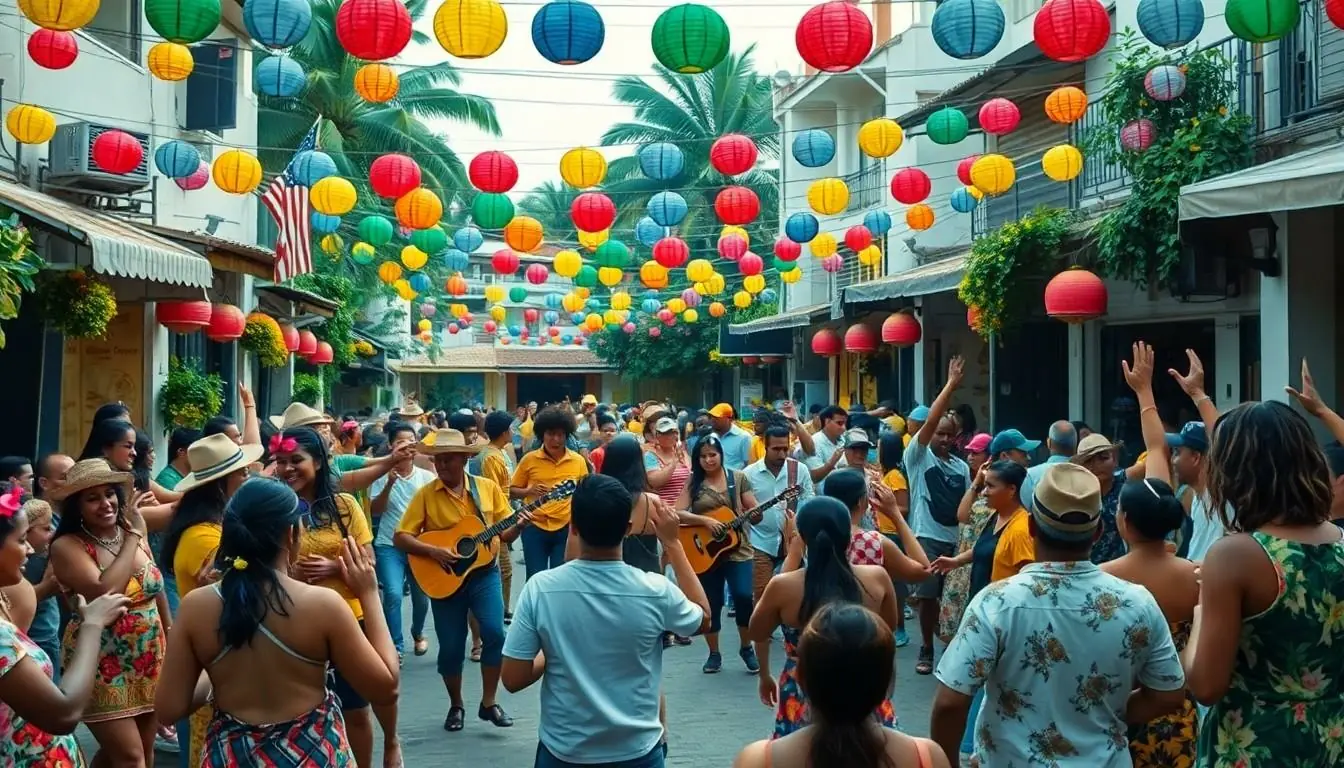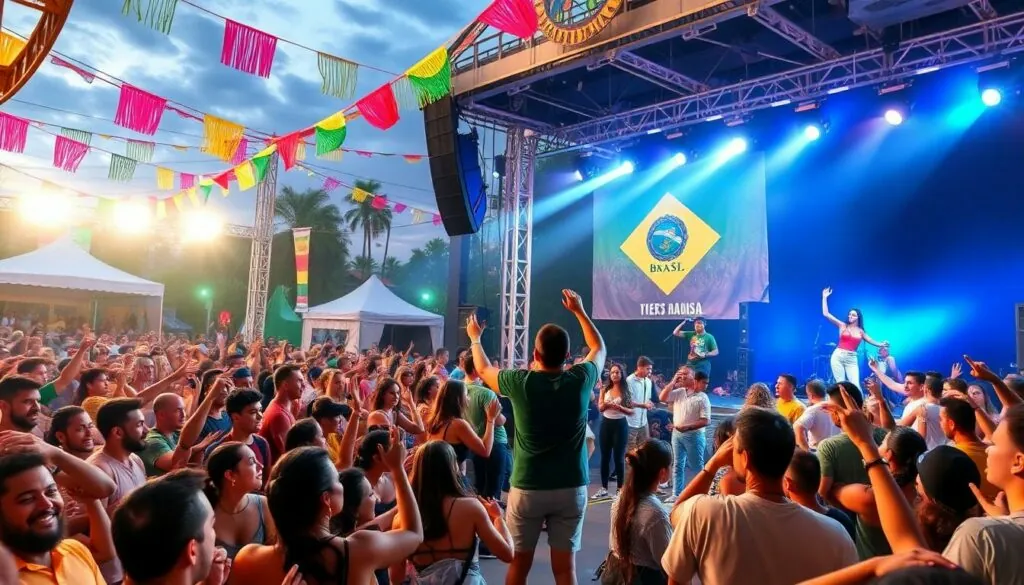Table of Contents
ToggleBrazilian pop music isn’t just a genre; it’s a vibrant explosion of rhythm, color, and culture that’ll make anyone want to dance like nobody’s watching. From the infectious beats of funk carioca to the soulful melodies of MPB, this musical landscape is a treasure trove waiting to be explored. If you think your playlist could use a little spice, it’s time to dive into the world of Brazilian pop.
What Is Brazilian Pop Music?
Brazilian pop music represents a vibrant blend of various styles, showcasing the country’s diverse cultural heritage. Funk carioca and MPB (Música Popular Brasileira) lead the genre, each reflecting different social and musical influences. The rhythms often incorporate elements from samba, bossa nova, and electronic music.
Artists like Anitta and Pabllo Vittar exemplify the modern sound of Brazilian pop, blending traditional influences with contemporary beats. Their tracks often feature infectious hooks, making them popular both in Brazil and internationally. The lyrics frequently address themes of love, social issues, and celebration, resonating with a broad audience.
This genre is marked by its energetic performances and visually captivating music videos. Collaborations between artists often enhance the appeal of Brazilian pop, bridging different styles and fan bases. Festivals play a key role in its popularity, with large events featuring multiple genres, including pop, funk, and rock.
Subgenres also emerge within Brazilian pop music. Axé and sertanejo have gained traction in recent years, introducing new melodic elements and dance styles. Each subgenre contributes to the overall richness, providing listeners with an array of musical experiences.
Listeners can expect Brazilian pop music to be both entertaining and culturally significant. The genre serves not only as a form of artistic expression but also as a reflection of Brazil’s vibrant society. Engaging with this music offers insight into the country’s ongoing narrative, celebrating its unique blend of tradition and modernity.
The Origins of Brazilian Pop Music

Brazilian pop music has deep roots, reflecting the country’s diverse musical landscape. With influences from local and international genres, its evolution showcases a mix of cultural expressions.
Historical Influences
Cultural movements shaped Brazilian pop music significantly. Samba emerged in the early 20th century, combining African rhythms with Portuguese melodies. Bossa nova followed in the 1950s, introducing a softer, jazz-influenced sound. The Tropicalia movement of the 1960s fused traditional music with rock and avant-garde elements. In more recent years, electronic music and hip-hop also contributed fresh influences. Each era’s artists integrated these styles into their works, enriching the genre’s history.
Key Genres Merging into Pop
Various genres merge into Brazilian pop, contributing to its vibrant sound. Funk carioca, known for its high-energy beats, became popular in the 1990s, emphasizing bass-driven rhythms. MPB blends folk and popular music, often incorporating rich storytelling in lyrics. Axé brings lively carnival rhythms, creating festive dance tracks. Sertanejo, akin to country music, resonates with both urban and rural audiences, adding emotional depth. The combination of these genres allows Brazilian pop music to appeal widely, fostering connections among diverse listeners.
Prominent Artists in Brazilian Pop Music
Brazilian pop music features a vibrant array of artists, each shaping the genre in unique ways.
Emerging Icons
Pabllo Vittar has quickly become a defining figure in Brazilian pop. Known for her powerful voice and energetic performances, she blends funk with pop elements, capturing a diverse audience. Anitta continues to rise as a pop powerhouse, incorporating reggaeton and dance beats into her music, which resonates across various cultures. The dynamic duo of Ludmilla and IZA showcases talent and creativity, with each artist bringing her own style and flair to the genre. Their songs often touch on themes of empowerment and self-expression, contributing to the genre’s fresh and modern sound.
Established Legends
Roberta Campos stands out as an influential artist in Brazilian pop. Famed for her emotive lyrics and melodic compositions, she combines traditional MPB roots with contemporary styles. Caetano Veloso, a foundational pioneer, melds Brazilian sounds with international influences, maintaining relevance in today’s music scene. Gilberto Gil, known for his innovative approach, continues to inspire younger generations of artists while showcasing the beauty of Brazilian culture. Finally, Gal Costa’s iconic voice and performances have left a lasting impact on the music landscape, solidifying her status as a legend in Brazilian pop.
The Evolution of Brazilian Pop Music
Brazilian pop music reflects a dynamic evolution influenced by cultural shifts and musical experimentation. Its journey showcases distinctive trends and significant global collaborations.
Trends Over the Decades
The 1960s introduced Tropicalia, a groundbreaking movement blending traditional Brazilian sounds with rock and avant-garde music. Disco influences surged in the 1970s, with artists adopting danceable rhythms. The 1980s saw the rise of MPB, merging rock elements with Brazilian music. As the 1990s approached, samba and bossa nova gained renewed interest through contemporary interpretations. Entering the 2000s, funk carioca emerged from the favelas, appealing to youth audiences and innovating popular sound. Recent years highlight the bold presence of artists like Anitta and Pabllo Vittar embracing pop aesthetics while addressing social issues. These trends reflect a vibrant, ever-evolving music scene, resonating with diverse listeners across Brazil.
International Influence and Collaboration
International collaborations increasingly characterize Brazilian pop music’s contemporary landscape. Partnerships with global artists expand reach, blending diverse sounds and styles. Anitta gained recognition through collaborations with artists such as J Balvin and Major Lazer, introducing Brazilian rhythms to worldwide audiences. Pabllo Vittar’s work with international figures like Charli XCX further highlights these cross-cultural connections. Additionally, elements of hip-hop and electronic music integrate into traditional Brazilian sounds, fostering innovation. Globalization facilitates this exchange, allowing Brazilian artists to infiltrate markets and cultivate international fan bases. The collaboration enriches both Brazilian pop and global music, creating a unique sound that resonates beyond borders.
The Future of Brazilian Pop Music
Brazilian pop music is evolving rapidly, reflecting both cultural shifts and technological advancements.
New Trends and Directions
Recent years highlight the rise of diverse sounds within Brazilian pop. Artists increasingly incorporate styles like trap and reggaeton, enhancing the genre’s sonic palette. Collaborations between genres continue to flourish, creating vibrant fusion tracks that resonate with broad audiences. Notably, social issues permeate lyrics, providing depth that challenges listeners. Additionally, the global appeal of artists ensures that Brazilian pop remains relevant on the world stage. Emerging talents frequently experiment with visuals, integrating fashion and dance to captivate fans. Innovations in songwriting techniques also emerge, paving the way for fresh narratives.
The Role of Digital Media
Digital media plays a crucial part in shaping Brazilian pop’s trajectory. Streaming platforms significantly boost accessibility, allowing listeners to discover new music more easily. Social media becomes a vital tool for artists, fostering direct engagement with fans and promoting new releases. Videos on platforms like YouTube showcase creative storytelling, expanding the visual aspect of music. Music challenges and viral trends amplify exposure, propelling songs to the top of charts. Furthermore, real-time feedback from audiences helps artists fine-tune their work and stay aligned with listener preferences. Overall, digital media creates a dynamic environment that shapes the future of Brazilian pop music.
Brazilian pop music stands as a testament to the nation’s rich cultural tapestry. Its ability to blend traditional sounds with contemporary influences showcases the genre’s dynamic nature. As artists continue to innovate and address relevant social themes, the music not only entertains but also connects listeners on a deeper level.
With its energetic rhythms and captivating performances, Brazilian pop music is poised to maintain its global appeal. The genre’s evolution reflects the spirit of a vibrant society that embraces change while honoring its roots. As fans explore this musical landscape, they’ll find a world of sounds that resonates far beyond Brazil’s borders.





